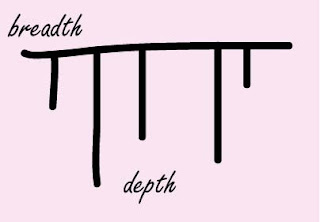 In CBT, identifying, questioning, and challenging your thoughts is complicated by the fact that a lot of thinking happens below the surface of conscious awareness. In fact, the cognitive model describes layers of cognition that are sometimes compared to the layers on an onion: peeling back the outer layers reveals the layers underneath. Using this metaphor, your conscious thoughts make up the skin on the outside of the onion. These are the thoughts you are most aware of at any particular moment – the thoughts in the forefront of your mind that make up your ongoing stream of consciousness. They include things that you are paying attention to, focusing on, or choosing to think about.
In CBT, identifying, questioning, and challenging your thoughts is complicated by the fact that a lot of thinking happens below the surface of conscious awareness. In fact, the cognitive model describes layers of cognition that are sometimes compared to the layers on an onion: peeling back the outer layers reveals the layers underneath. Using this metaphor, your conscious thoughts make up the skin on the outside of the onion. These are the thoughts you are most aware of at any particular moment – the thoughts in the forefront of your mind that make up your ongoing stream of consciousness. They include things that you are paying attention to, focusing on, or choosing to think about. Just underneath your conscious thoughts is a layer of what are known as “automatic thoughts.” As the name implies, these thoughts happen automatically – without conscious deliberation. They are typically judgments or evaluations, and are generally brief – sometimes only a few words or a mental image. Automatic thoughts happen so quickly that we are barely aware of them; however, they are relatively easy to bring into conscious awareness because they often produce a shift in mood or emotion. You can become aware of your automatic thoughts by noticing changes in how you feel, and asking yourself: “What was just going through my mind?”
Automatic thoughts, in turn, give us clues about the interior layers of the onion – our intermediate and core beliefs. Beginning in early childhood, we develop beliefs about ourselves, other people, and the world we live in. Some of these beliefs are so fundamental to how we view everything that we see them as absolute truths. We call these "core beliefs." Core beliefs are the basic assumptions that determine to what degree you see yourself as worthy/unworthy, safe/threatened, competent/incompetent, powerful/vulnerable, independent/dependently, and loved/unlovable. They also establish your sense of belonging and how you expect to be treated by others.
Although we are often not consciously aware of our core beliefs, they have a significant impact on us: situations in daily life activate core beliefs, which then shape our perception and interpretation of the situation. The way that core beliefs influence our perception, interpretation, and response to a situation is through what are called "intermediate beliefs." These include our attitudes, assumptions, and rules. Attitudes are evaluative statements (e.g., "It would be terrible if..."), assumptions tend to be "if...then..." statements, and rules are "should" (or must, or ought) statements. Intermediate beliefs arise from core beliefs, either as logical extensions of them, or as attempts to cope or compensate for what we believe is true, for example: “I am inadequate so I need to work harder than everyone else.” “I am unlovable, so I should expect rejection.”
Core beliefs can be combined in patterns called “schemas,” along with associated intermediate beliefs, and the emotions, body sensations, and behaviors they produce. Schemas serve as templates for processing and understanding life experiences, filtering incoming information so that we take in information that fits our existing core beliefs, while screening out anything that contradicts our beliefs. Schemas also shape the content of conscious and automatic thoughts. Automatic thoughts, in turn, strengthen and reinforce beliefs: the more you “hear” yourself think something, the more convinced you are that it is true. These processes together make core beliefs difficult to change. However, the time and effort needed to change them has a significant payoff: the resulting changes to intermediate beliefs and automatic thoughts can produce lasting emotional and behavioral benefits.




